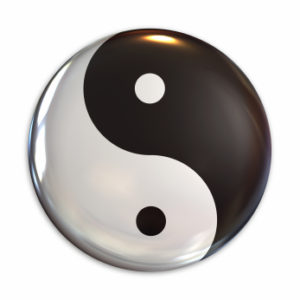Evolution
The ancient Chinese believe that in the beginning there is a state of nothingness or a void and they call it Wu Ji and it is symbolized by a circle.
Out of this nothingness come two primary energies which are the opposite of each other. One is active while the other is passive. The active energy is called yang while the passive energy is called Yin.
The Yin Yang is often depicted by the Tai Ji symbol. It is a circle made up of two different tadpole or fish like parts, one in black and the other in white The black potion symbolizes the Yin energies while the white portion symbolizes the Yang energies.
On the Yang side (represented by the white tadpole) lies the seed of Yin (represented by the black dot) and vice-versa. The symbol suggest that Yang grows but at its height, Yin emerge. Then Yin grows and at its height Yang appears. The growing and contracting of the Yin and Yang suggest that a never ending cycle of change.
The symmetry and close the close contact between the Yin and Yang portion symbol also suggest that both are important and equal and neither one is more important or conquer the other.
Another way to look at Yin and Yang is contraction and expansion!
Application
The concept of Yin Yang is pervasive in Chinese Medicine. You can see its application in Feng Shui, Astrology, Chinese Medicine, Martial Arts etc.
Let me share with you an example from Chinese Medicine.
We are well when the Yin and Yang of our body is in a state of balance. But when the body body goes out of balance or when when there is too much Yin or Yang, we fall sick. The aim is to keep the body in balance.
This is why watermelon is consumed in Summer while double boiled soup is preferred in winter. Watermelon has a cooling effect and it serves to cool the body during the hot summer months. In Winter, the hot double boiled soup provide balance by warming the body.
Examples of Yin Yang
This concept of Yin Yang can be applied to everything. For example strong is Yang while Weak is Yin. Traits such as day, summer, sun, motion, white, angular, shiny for example can be classified as Yang while night, winter, moon, stillness, black, smooth and dull can be classified as Yin.
When applied to seasons, Yin is winter while Yang is summer. Spring is a period of increasing Yang while autumn is a period of increasing Yin.
When applied to plants, live plant is Yang while dead wood e.g. table and chair is Yin. Live plants can be further classified where a large tree is Yang and the small plant is Yin. Those with rounded leaves are Yin while those with narrow leaves are Yang.
When applied to objects those that are small, rounded, dull and cold to the touch is Yin. Those that are large, angular, shiny and warm to the touch are Yang. What about jewellery like tungsten rings which are both metallic and rounded? Since it’s a metal, and a dull metal, it maybe classified as yin while shiny gold is more yang.
In humans, the left brain (logic) is Yang while the right brain (creativity) is Yin. Those with boastful, loud, aggressive and impulsive personalities are Yin while those with shy, quiet, soft-spoken and patient personalities are Yang.
The human body can also be classified into Yin and Yang. The front and the part below the waist is Yin while the back and the part above the waist is Yang. The internal organs can be classified too. The heart, lung, liver, spleen and kidney are Yin while the small and large intestine, gall bladder, stomach and bladder are Yang organs.
What about spaces? The bedroom, study and storeroom are Yin. The living room, kitchen, family area and dining are Yang. Generally speaking those areas that require less noise and lighting where it is easier to concentrate or rest is Yin and vice versa.
Finally what about the Five Elements? You may have heard of Yin and Yang Water. Yin Water is one that is still and do not move. For example water in a jar. Yang Water on the other hand has movement such as a water fountain or aquarium.
Is the river Yin or Yang water? If you follow the course of a river from source to sea, you will notice that there are places where a river slows down considerable and also place where it accelerates. In general a river is yang but within Yang you have also places where it is more Yin (when it slows down) and places where it is more Yang (when it accelerates).
Yin Yang in Feng Shui
Just like our body, we are also striving for balance in our home. For example, the concrete structure of your home is Yang while the plants in the garden is Yin. A good Feng Shui home should ideally have a mix of concrete structure and landscaping.
A large home with very few occupants is considered to be Yin. A house that is brightly lit and painted entirely in white is too yang. A home that is dark with small doors and windows that are closed most of the time is too Yin and considered to be out of balance.
Finally, Feng Shui for dwellings or houses of the living is called Yang Feng Shui while Feng Shui for the graves or houses of the dead is called Yin Feng Shui.

